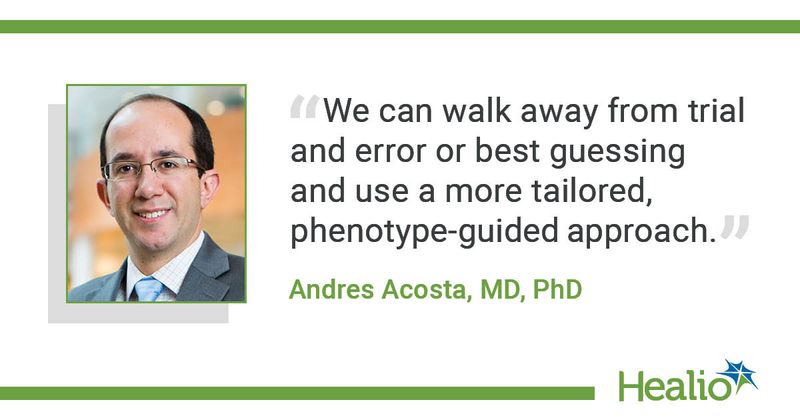Novel obesity classifications can aid in tailoring weight-loss treatments
Phenotype-guided obesity interventions, determined by a blood test, can double weight loss for patients compared with standard obesity care, according to a presenter at the Obesity Medicine Association 2021 virtual conference.
Obesity is a complex, heterogenous, multifactorial disease, and a one-size-fits-all treatment will not work for many patients, Andres Acosta, MD, PhD, assistant professor of medicine and director of the precision medicine for obesity program at Mayo Clinic, said during a presentation. Weight loss varies widely for people with excess weight, and a better solution lies in using precision medicine to target the right treatments to each person based on what is driving their disease.

“We have identified new classifications of obesity based on pathophysiological and behavioral phenotypes, and this can enhance weight loss with medication and improve the percentage of patients who respond to medication,” Acosta told Healio. “We can walk away from trial and error or best guessing and use a more tailored, phenotype-guided approach.”
Recognize individual variability
Most obesity medicine guidelines and expert opinion state that patient comorbidities and patient preference should be considered when choosing pharmacotherapy for weight management, Acosta said.
“What we are proposing is a different approach,” Acosta said. “We try to pair the unique characteristics of the patient with a medication based on its mechanism of action. Our most recent study on this — with 84 patients treated with this approach — showed a 1.75 greater likelihood of losing more weight [vs. standard care].”
As Healio previously reported, Acosta and colleagues used various methods to categorize 450 study participants (mean age, 39 years; 72% women; 93% white) into four phenotypes. “Hungry brain” was measured using kilocalories consumed at an ad libitum buffet meal and a visual analog scale measuring satisfaction 30 minutes after a meal. “Hungry gut” was calculated through a visual analog scale measuring fullness 2 hours after a meal and gastric emptying time after a meal. “Emotional hunger” combined the score of an eating factor questionnaire focused on emotional restraint and anxiety level through the hospital anxiety depression scale. “Slow burn” was measured through predicted residual energy expenditure, self-reported number of steps and self-reported exercise. All data were collected during a “phenotype day” at the Mayo Clinic.
In the study cohort, 18% fell into the hungry gut phenotype, 16% were categorized as hungry brain and 12% each were placed into emotional hunger and slow burn phenotypes. About 27% of participants were categorized into multiple phenotypes, and 15% had an unknown phenotype. After 12 months, 79% of the phenotype group had a 10% or greater weight loss vs. 35% in the nonphenotyped group.
Acosta said phenotype data could be used to select ideal responders for a breakthrough obesity therapy like the weekly GLP-1 receptor agonist semaglutide (Ozempic, Novo Nordisk), which was associated with substantial, sustained weight loss among a cohort of people with obesity compared with placebo.
“If we can identify who are those [responders], those patients will never require bariatric surgery, because the weight loss [with semaglutide] is equivalent to bariatric surgery,” Acosta told Healio. “But then, we have 60% of the patients who are only losing 10% of body weight. Maybe semaglutide is not as beneficial for those people.”
Choosing the right tools
Acosta said obesity management will never be about finding “one magic pill” that works for everyone. Instead, weight management will always involve choosing the best solutions among multiple options, including medications, devices, surgery or a more intensive lifestyle intervention.
“We have been saying that obesity is a disease for almost a decade now,” Acosta said. “But it is very difficult to explain [to patients] why obesity is a disease. People feel like they are a failure. There is stigma.”
By identifying a patient with a specific obesity phenotype, a clinician can then explain to the patient why they struggle to lose weight, Acosta said.
During a Q&A session after the presentation, Acosta acknowledged that daylong testing to identify the four obesity phenotypes is not practical for the busy clinician. Acosta and his research team are working to develop a biomarker measured via a blood test that can accurately discern obesity phenotypes.
“It is our hope that we can simplify [determining] these obesity phenotypes with something like a lipid panel, that then can help us guide therapy and know who has what type of obesity and what treatment is best,” Acosta said. “In the meantime, talk with your patients about these variables that might matter and help you improve outcomes.
“[Obesity] could be due to genetics, the environment, medications you are taking,” Acosta said. “Once you address the problem and identify what is unique for that individual, you remove the stigma around the disease. Then, you treat it like any other disease. Then, it is easy to say, if diet is not enough, ‘I have tools that can help you deal with these specific problems.’”
